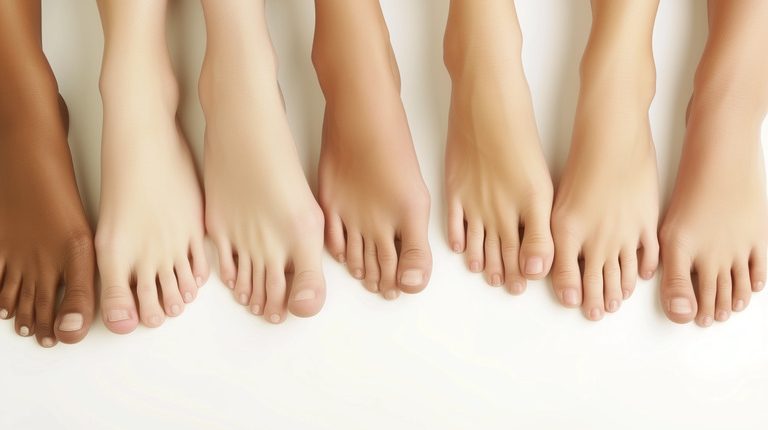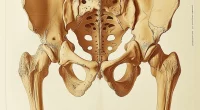Hammertoe
What’s that?
Hammertoes are an acquired deformity within transverse flatfoot, characterized by extension of the nail phalanx, flexion of the middle phalanx, and extension (or flexion) of the main phalanx.
About the disease
In this deformity, the tendon part of the finger extensor is shortened and under tension. A painful callus is often formed on the dorsal surface of the first interphalangeal joint. In advanced cases, the curvature is accompanied by severe flexion of the main phalanx with complete dislocation of its base, stiffness of the first interphalangeal joint, and rough, painful calluses on the sole and rear. The phalanges of the fingers are elevated and do not touch the surface when walking.
A prolonged dissonance is formed between flexion and extension forces in relation to the toes in a hammertoe deformity. This disorder is associated with both external and internal factors. Hammer-shaped curvature is considered one of the most common, especially among patients of the older age group. It accounts for a third of the cases of foot and ankle pathology. More often, the second toe is deformed, and less frequently – the III-V toes. To a greater extent, this pathology affects women.
The initial stages of curvature are unstable and can be corrected by passive action, particularly manual techniques. However, the pathological process progresses over time, and the changes become organic, with partial or complete dislocation of the first finger phalanx. The appearance of intense pain accompanies this process. Redistribution of pressure within the forefoot leads to calluses, and some patients even form wounds. At this stage, the surgical treatment question is decided to correct the situation. The doctor selects the optimal method of surgical intervention.
Types of deformation
Based on the results of Hamilton’s test, there are 4 degrees of hammertoe curvature of the fingers of the lower limb:
- first degree – slight instability, with the exact ratio of the articular surfaces reduced by less than half;
- second degree – moderate instability (the surfaces of the articular ends of the bone lose the correct ratio over 50% of the length)
- third degree – pronounced instability (the finger is dislocated during the diagnostic test);
- the fourth degree is a dislocation that passive methods cannot repair.
It is believed that the more pronounced the instability of the joint, the more severely the plantar ligament is affected.
Symptoms
The main manifestations of hammertoe curvature are:
- pain sensations, the intensity of which increases with the progression of the pathological process;
- a visible deformity that disrupts the aesthetics of the foot and makes it impossible to wear model shoes.
On objective examination, the traumatologist finds abnormal flexion in the first interphalangeal joint, with overextension in the second interphalangeal joint. The metatarsophalangeal joint is in a similar position. In most cases, the affected toe is deviated toward the rear of the foot.
Reasons
The nature of hammertoe curvature is multifaceted. Possible predisposing factors may be:
- wearing narrow shoes that squeeze the forefoot;
- neuro-myofascial pathologies;
- traumatic injuries;
- congenital foot abnormalities.
It is worth considering that curvature of the second to fourth toe can be an independent nosology or a consequence of concomitant foot deformities. These features are taken into account when choosing the best treatment option.
Diagnosis
The diagnostic search includes performing the following examinations:
- Hamilton’s test. This method allows you to determine the pronounced organic changes in the metatarsophalangeal joint. Based on this data, the degree of instability of the joint is determined.
- X-ray scan of the feet. This study is performed in at least two projections with the foot under load to assess the deformity properly.
- Magnetic resonance imaging. The study allows visualization of a plantar ligament rupture.
Hammer toe treatment
Conservative treatment of hammer toe allows you to reduce pain, but the neglected pathological process continues to progress (curvature increases over time). Surgery will enable you to affect not only the pain but also the severity of the deformity. The optimal treatment program is determined by the elasticity of the metatarsophalangeal joint and the degree of curvature.
Conservative treatment
Conservative treatment may include taping the affected toe or wearing orthopedic fixators. These options can help relieve pain in elastic curvature (before permanent organic changes develop). However, these options require special shoes that cannot compress the foot with the fixators together.
Surgical treatment
The absolute indication for surgery for hammertoe curvature is a persistent pain syndrome, which cannot be managed by adequately selected conservative therapy. The question in favor of surgical treatment may also be decided in the presence of concomitant foot deformity (e.g., valgus deformity).
Surgery is not performed in the presence of contraindications, which include active infectious inflammation and poor blood flow in the foot area. The patient’s desire to correct only a cosmetic defect is a relative indication, as well as the inability to select adequate footwear.
In modern orthopedics, the most commonly used surgery options for hammer toe are as follows:
- reconstructive-plastic surgery in the region of the first interphalangeal joint;
- creating immobility in the joint area;
- displacement or lengthening of the tendon compartment;
- minimally invasive intervention with osteotomy of the base of the proximal phalanx;
- osteotomy of the second metatarsal bone;
- plantar ligament repair in the area of the articulation of the metatarsal bone and the toe phalanx.
Minimally invasive surgeries have several advantages, so they are increasingly being introduced in clinical practice. Such interventions are characterized by the least trauma, minimal pain syndrome in the postoperative period, and insignificant risk of infectious complications. After minimally invasive surgery, the recovery time is short, and the best cosmetic results are achieved (barely noticeable scars remain).
All these surgical options are available in more than 800 hospitals worldwide (https://doctor.global/results/diseases/hammertoe). For example, hammer toe surgery can be done in 45 clinics across Germany for an approximate price of $5,148 (https://doctor.global/results/europe/germany/all-cities/all-specializations/procedures/hammer-toe-surgery).
Prevention
The following recommendations can help reduce the risk of acquired deformity:
- wearing comfortable, spacious shoes that do not squeeze the forefoot;
- the use of orthopedic insoles that evenly distribute the load on all parts of the foot;
- optimizing physical activity;
- timely correction of existing pathologies of the musculoskeletal system.
Rehabilitation
After surgical treatment of the foot is recommended:
- physical therapy;
- taping;
- massage;
- wearing the most physiologically appropriate footwear.




